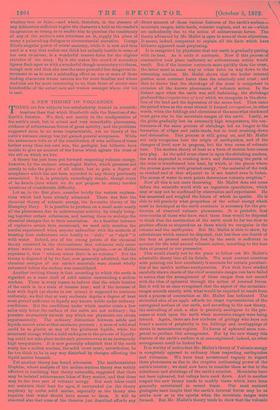A NEW THEORY OF VOLCANOES.
THERE are few subjects less satisfactorily treated in scientific treatises than that which Humboldt calls the Reaction of the Earth's Interior. We find, not merely in the configuration of the earth's crust, but in actual and very remarkable phenomena, evidence of subterranean forces of great activity, and the problems suggested seem in no sense impracticable, yet no theory of the earth's volcanic energy has yet gained general acceptance. While the astronomer tells us of the constitution of orbs millions of times farther away than our own sun, the geologist has hitherto been unable to give an account of the forces which agitate the crust of the orb on which we live.
A theory has just been put forward respecting volcanic energy, however, by the eminent seismologist Mallet, which promises not merely to take the place of all others, but to gain a degree of acceptance which has not been accorded to any theory previously enunciated. It is, in principle, exceedingly simple, though many of he details (into which we do not propose to enter) involve questions of considerable difficulty.
Let us, in the first place, consider briefly the various explana- tions which had been already advanced. There was first the chemical theory of volcanic energy, the favourite theory of Sir litimphry Davy. It is possible to produce on a small scale nearly all the phenomena due to subterranean activity, by simply bring- ing together certain substances, and leaving them to undergo the chemical changes due to their association. As a familiar instance of explosive action thus occasioned, we need only mention the results experienced when anyone unfamiliar with the methods of treating lime endeavours over hastily to " slake " or " slack " it with water. Indeed, one of the strong points of the chemical theory consisted in the circumstance that volcanoes only occur where water can reach the subterranean regions,—or as Mallet expresses it, that " without water there is no volcano." But the theory is disposed of by the fact, now generally admitted, that the chemical energies of our earth's materials were almost wholly exhausted before the surface was consolidated.
Another inviting theory is that according to which the earth is regarded as a mere shell of solid matter surrounding a molten nucleus. There is every reason to believe that the whole interior of the earth is in a state of intense heat ; and if the increase of heat with depth (as shown in our mines) is supposed to continue uniformly, we find that at very moderate depths a degree .of heat must prevail sufficient to liquefy any known solids under ordinary conditions. But the conditions under which matter exists a few miles only below the surface of the earth are not ordinary ; the pressure enormously exceeds any which our physicists can obtain experimentally. The ordinary distinction between solids and liquids cannot exist at that enormous pressure ; a mass of cold steel could be as plastic as any of the glutinous liquids, while the structural change which a solid undergoes in the process of liquefy- ing could not take place under such pressure even at an enormously high temperature. It is now generally admitted that if the earth really has a molten nucleus, the solid crust mast, nevertheless, be far too thick to be in any way disturbed by changes affecting the liquid matter beneath.
Yet another theory has found advocates. The mathematician Hopkins, whose analysis of the molten-nucleus theory was mainly effective in rendering that theory untenable, suggested that there may be isolated subterranean lakes of fiery matter, and that these may be the true seat of volcanic energy. But such lakes could not maintain their heat for ages, if surrounded (as the theory requires) by cooler solid matter, especially as the theory also requires that water should have access to them. It will be observed also that none of the theories jest described affords any direct account of those various features of the earth's surface— mountain ranges, table-lands, volcanic regions, and so on—which are undoubtedly due to the action of subterranean forces. The theory advanced by Mr. Mallet is open to none of these objections. It seems, indeed, competent to explain all the facts which have hitherto appeared most perplexing.
It is recognised by physicists that our earth is gradually parting with its heat. As it cools it contracts. Now if this process of contraction took place uniformly no subterranean action would result. But if the interior contracts more quickly than the crust, the latter must in some way or other force its way down to the retreating nucleus. Mr. Mallet shows that the hotter internal portion must contract faster than the relatively cool crust; and then he shows that the shrinkage of the crust is competent to occasion all the known phenomena of volcanic action. In the distant ages when the earth was still fashioning, the shrinkage produced the irregularities of level which we recognise in the eleva- tion of the land and the depression of the ocean-bed. Then came the period when as the crust shrank it formed corrugations, in other words, when the foldings and elevations of the somewhat thickened crust gave rise to the mountain-ranges of the earth. Lastly, as the globe gradually lost its extremely high temperature, the con- tinuance of the same process of shrinkage led no longer to the formation of ridges and table-lands, but to local crushing-down and dislocation. This process is still going on, and Mr. Mallet not only recognises here the origin of earthquakes, and of the changes of level now in progress, but the true cause of volcanic heat. The modern theory of heat as a form of motion here cornea into play. As the solid oiliest closes in upon the shrinking nucleus, the work expended in crushing down and dislocating the parts of the crust is transformed into heat, by which, at the places where the process goes on with greatest energy, "the material of the rock so crushed and of that adjacent to it are heated even to fusion. The access of water tio such points determines volcanic eruption."
Now all this is not mere theorising. Mr. Mallet does not come before the scientific world with an ingenious speculation, which may or may not be confirmed by observation and experiment. He has measured and weighed the forces of which he speaks. Hels able to tell precisely what proportion of the actual energy which must be developed as the earth contracts is necessary for the pro- duction of observed volcanic phenomena. It is probable that nine-tenths of those who have read these lines would be disposed to think that the contraction of the earth must be far too slow to produce effects so stupendous as those which we recognise in the volcano and the earthquake. But Mr. Mallet is able to show, by calculations which cannot be disputed, that less than one-fourth of the heat at present annually lost by the earth is sufficient to account for the total annual volcanic action, according to the best data at present in our possession.
This would clearly not be the place to follow out Mr. Mallet's admirable theory into all its details. We must content ourselves with pointing out how excellently it accounts for certain peculiari- ties of the earth's surface-configuration. Few that have studied carefully drawn charts of the chief mountain-ranges can have failed to notice that the arrangement of these ranges does not accord with the idea of upheaval through the action of internal forces. But it will be at once recognised that the aspect of the mountain- ranges accords exactly with what would be expected to result from such a process of contraction as Mr. Mallet has indicated. The shrivelled skin of an apple affords no inapt representation of the corrugated surface of our earth, and according to the new theory, the shrivelling of such a skin is precisely analogous to the pro- cesses at work upon the earth when mountain-ranges were being formed. Again, there are few students of geology who have not found a source of perplexity in the foldinga and overlappings of strata in mountainous regions. No forces of upheaval seem com- petent to produce this arrangement. But by the new theory this feature of the earth's surface is at once explained; indeed, no other arrangement could be looked for.
It is worthy of notice that Mr. Mallet's theory of Volcanic energy is completely opposed to ordinary ideas respecting earthquakes and volcanoes. We have been accustomed vaguely to regard these phenomena as due to the eruptive ontbursting power of the earth's interior ; we shall now have to consider them as due to the subsidence and shrinkage of the earth's exterior. Mountains have not been upheaved, but valleys have sunk down. And in another respect the new theory tends to modify views which have been generally entertained in recent times. Our most eminent geologists have taught that the earth's internal forces may be as active now as in the epochs when the mountain ranges were formed. But Mr. Mallet's theory tends to show that the volcanic
energy of the earth is a declining force. Its chief action had already been exerted when mountains began to be formed ; what remains now is but the minutest fraction of the volcanic energy of the mountain-forming era ; and each year, as the earth parts with more and more of its internal heat, the sources of her subterranean energy are more and more exhausted. The thought once entertained by astronomers that the earth might explode like a bomb, her scattered fragments producing a ring of bodies resembling the zone of asteroids, seems further than ever from probability ; if ever there was any danger of such a catastrophe, the danger has long since passed away.



































 Previous page
Previous page